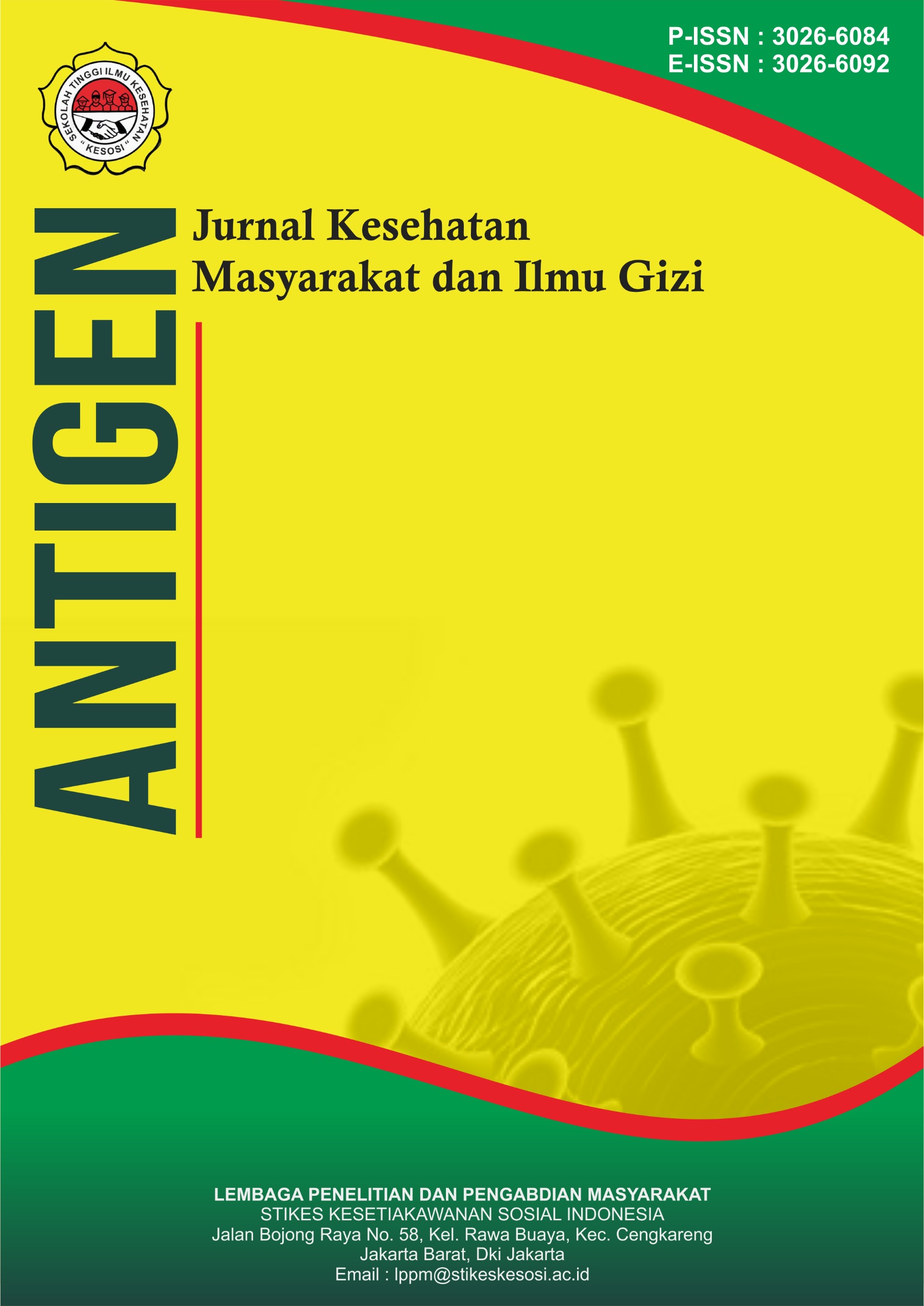Analisis Faktor Faktor yang Berhubungan dengan Tingkat Kelelahan Mata di PT. Total Enviro Solusindo
DOI:
https://doi.org/10.57213/antigen.v3i3.780Keywords:
Eye Fatigue, Gender, Screen Time, Lighting, Individual FactorsAbstract
This study aims to determine the relationship between individual and environmental factors with the level of eye fatigue in employees. This quantitative study used a cross-sectional design. A total of 60 respondents were selected using total sampling. Data were collected through questionnaires and analyzed using the chi-square test. The variables assessed included age, gender, history of visual impairment, duration of screen use, and lighting intensity in the workplace. The results showed that only gender had a statistically significant association with eyestrain (p = 0.034). Other variables-age (p = 0.859), history of visual impairment (p = 0.482), duration of screen use (p = 0.764), and lighting intensity (p = 0.158)-had no significant association. Most respondents (71.7%) experienced moderate levels of eyestrain. Gender was the only factor significantly associated with eyestrain in administrative workers. While other variables did not show a significant relationship, they are still relevant in the effort to maintain eye health in the workplace.
References
Al-Qaradawi, Y. (2020). Fiqh Maqasid Syariah. Maktabah Wahbah.
Ajzen, I. (1991). The theory of planned behavior. Organizational Behavior and Human Decision Processes, 50(2), 179–211.
American Optometric Association. (2023). Computer Vision Syndrome. Diakses dari https://www.aoa.org
Anshel, J. (2007). Visual ergonomics handbook. CRC Press.
API. (2024). Studi K3 di industri tekstil.
Blehm, C., Vishnu, S., Khattak, A., Mitra, S., & Yee, R. W. (2005). Computer vision syndrome: A review. Survey of Ophthalmology, 50(3), 253–262.
Geller, E. S. (2020). Behavior-based safety: Understanding people and performance. CRC Press.
Iqbal, M., El-Massry, A., & Bahgat, N. (2018). The impact of corrective lenses on visual fatigue in VDU users. Journal of Occupational Health, 60(4), 329–337.
Jayanti, D., & Wahyuni, S. (2017). Hubungan umur dan masa kerja dengan kecelakaan kerja pada pekerja industri. Jurnal Kesehatan Masyarakat, 12(1), 45–51.
Notoatmodjo, S. (2021). Promosi kesehatan dan perilaku kesehatan. Rineka Cipta.
Pratiwi, D., & Sari, L. (2022). Hubungan antara paparan layar komputer dengan kelelahan mata pada pekerja administrasi. Jurnal Kesehatan Kerja, 10(2), 88–95.
Rosenfield, M. (2016). Computer vision syndrome: A review of ocular causes and potential treatments. Ophthalmic and Physiological Optics, 36(5), 502–515.
Rosenstock, I. M. (1974). The health belief model and preventive health behavior. Health Education Monographs, 2, 354–386.
Sekaran, U., & Bougie, R. (2022). Research methods for business: A skill-building approach (8th ed.). Wiley.
Setyawati, R. (2021). Hubungan umur dengan penyerapan materi K3 di pelatihan industri. Jurnal Ilmu Kesehatan dan Keselamatan Kerja, 6(1), 20–26.
Sheedy, J. E., Hayes, J., & Engle, J. (2003). Is all asthenopia the same?. Optometry and Vision Science, 80(11), 732–739.
Smith, A. (2022). Bridging the safety knowledge-behavior gap in industrial settings. Safety Science, 145, 105509.
Sugiyono, & Purnama, A. (2023). Pengaruh kombinasi umur dan masa kerja terhadap pengetahuan K3. Jurnal Keselamatan Kerja Indonesia, 8(1), 55–62.
Suma’mur, P. K. (2021). Higiene perusahaan dan kesehatan kerja. Sagung Seto.
Vinodkumar, M. N., & Bhasi, M. (2020). The impact of safety knowledge on occupational accidents in chemical industries. Journal of Safety Research, 72, 89–98.
Wardani, A. (2023). Pengaruh masa kerja terhadap tingkat pengetahuan K3 di pabrik manufaktur. Jurnal K3 Nasional, 4(2), 103–110.
Yuliana, D. (2023). Pengaruh usia terhadap keluhan visual akibat penggunaan perangkat digital. Jurnal Ergonomi Indonesia, 5(1), 33–40.
Downloads
Published
Issue
Section
License
Copyright (c) 2025 Antigen : Jurnal Kesehatan Masyarakat dan Ilmu Gizi

This work is licensed under a Creative Commons Attribution-ShareAlike 4.0 International License.






